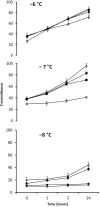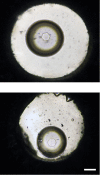Ice-Active Substances from the Infective Juveniles of the Freeze Tolerant Entomopathogenic Nematode, Steinernema feltiae
- PMID: 27227961
- PMCID: PMC4882034
- DOI: 10.1371/journal.pone.0156502
Ice-Active Substances from the Infective Juveniles of the Freeze Tolerant Entomopathogenic Nematode, Steinernema feltiae
Abstract
Steinernema feltiae is a moderately freezing tolerant nematode, that can withstand intracellular ice formation. We investigated recrystallization inhibition, thermal hysteresis and ice nucleation activities in the infective juveniles of S. feltiae. Both the splat cooling assay and optical recrystallometry indicate the presence of ice active substances that inhibit recrystallization in the nematode extract. The substance is relatively heat stable and largely retains the recrystallization inhibition activity after heating. No thermal hysteresis activity was detected but the extract had a typical hexagonal crystal shape when grown from a single seed crystal and weak ice nucleation activity. An ice active substance is present in a low concentration, which may be involved in the freezing survival of this species by inhibiting ice recrystallization.
Conflict of interest statement
Figures








References
-
- Ramløv H. Aspects of natural cold tolerance in ectothermic animals. Human Reprod. 2000;15(Suppl 5):26–46. - PubMed
-
- Wharton DA, Goodall G, Marshall CJ. Freezing rate affects the survival of a short-term freezing stress in Panagrolaimus davidi, an Antarctic nematode that survives intracellular freezing. CryoLetters. 2002;23(1):5–10. - PubMed
MeSH terms
Substances
LinkOut - more resources
Full Text Sources
Other Literature Sources

